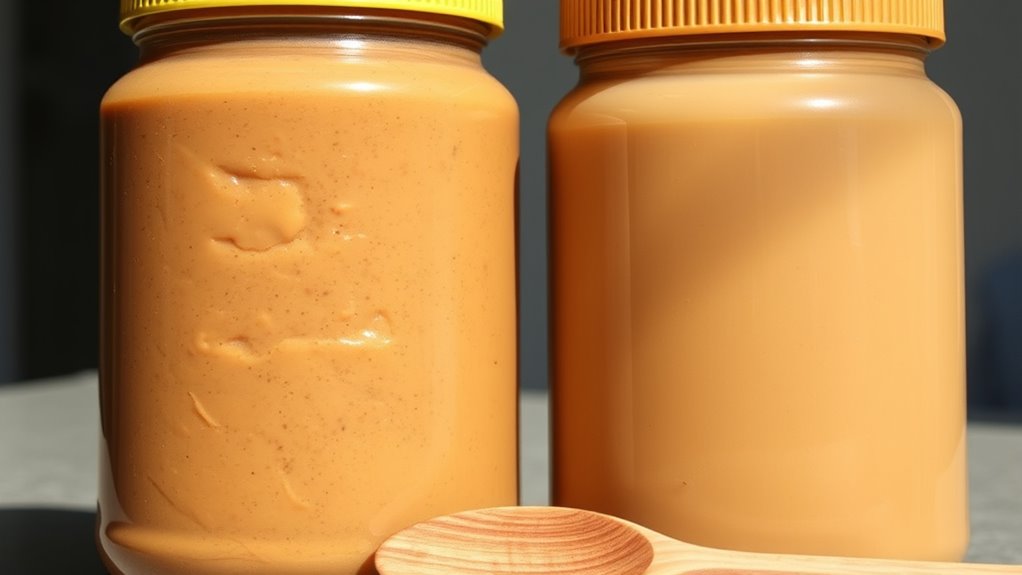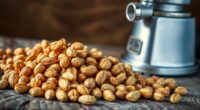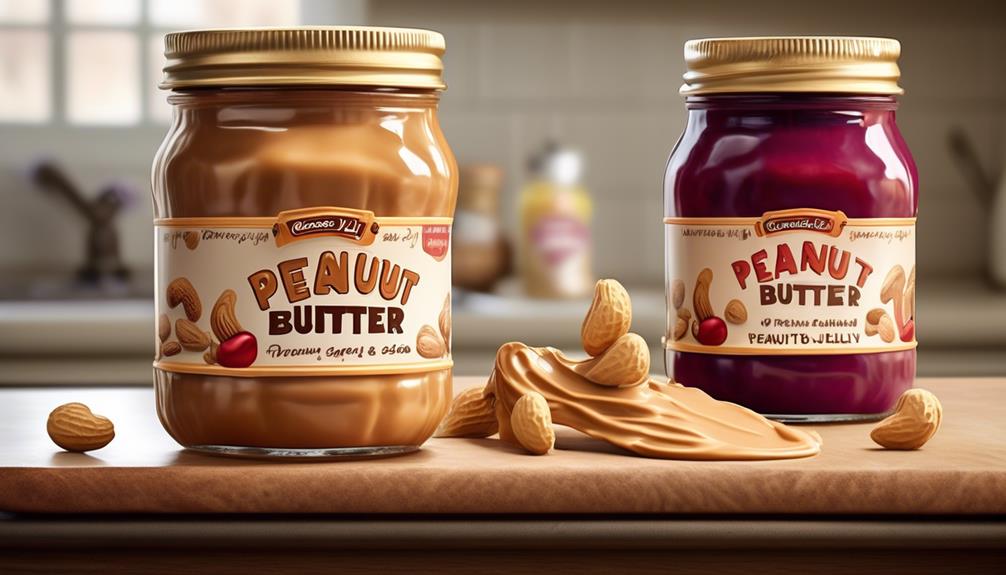Natural peanut butter contains just peanuts and maybe salt, while conventional types often add sugars and oils. This simplicity benefits your health by avoiding mystery additives. You’ll notice natural peanut butter has a robust nutty flavor and might require stirring due to oil separation, unlike the smoother and sweeter conventional options. While natural ones support health-conscious choices, conventional kinds provide more convenience. If you want to explore more about these differences, there’s plenty more to uncover.
Key Takeaways
- Natural peanut butter contains only peanuts and possibly salt, while conventional peanut butter often includes added sugars and preservatives.
- Natural peanut butter is less processed, maintaining nutrient integrity, whereas conventional options have added ingredients that can dilute health benefits.
- The taste of natural peanut butter is robust and nutty, while conventional peanut butter is typically smoother and sweeter.
- Oil separation in natural peanut butter indicates minimal processing, while conventional peanut butter remains creamy due to preservatives.
- Choosing between them depends on personal values, nutritional goals, and taste preferences regarding ingredient transparency and health benefits.

When you reach for a jar of peanut butter, you might wonder whether to choose natural or conventional. This decision can feel overwhelming, especially when health trends emphasize the importance of ingredient transparency and healthy fats. Both types have their merits, but understanding what sets them apart can help you make an informed choice.
Natural peanut butter typically contains just peanuts and maybe a little salt. That’s it! The simplicity means you know exactly what you’re eating, and you can trust that you’re getting healthy fats without any mystery additives. This transparency appeals to many health-conscious individuals who want to avoid unnecessary ingredients. You can easily see the oil separation in natural peanut butter, which often requires a good stir before you dig in. This is a sign that it hasn’t been overly processed, keeping the nutrients intact.
Natural peanut butter offers simplicity with just peanuts and salt, providing transparency and healthy fats without unnecessary additives.
On the other hand, conventional peanut butter often contains added sugars, hydrogenated oils, and preservatives to enhance flavor and extend shelf life. While this might make it taste creamier or sweeter, those added ingredients can turn a healthy snack into something less nutritious. When you’re looking for a source of healthy fats, these additives can dilute the overall health benefits of the peanut butter. If you’re trying to maintain a balanced diet, it’s essential to read the label closely. Ingredient transparency in conventional brands may not be as clear-cut, making it harder for you to determine what you’re really consuming.
In terms of taste, natural peanut butter has a more robust, nutty flavor, while conventional options might feel smoother. If you’re after a quick fix for your peanut butter cravings, you might find the conventional variety more appealing. However, if you’re focusing on health, natural peanut butter is likely the better choice. Additionally, choosing natural peanut butter aligns with the idea of ethical consumption, which emphasizes making informed choices about the food we eat.
Ultimately, the decision comes down to your personal preferences and nutritional goals. If you prioritize healthy fats and know exactly what’s in your food, natural peanut butter is your best bet. But if convenience and taste are your primary concerns, conventional might win you over. Just remember to weigh the trade-offs carefully, keeping in mind that ingredient transparency can profoundly impact your health choices. So next time you’re at the store, think about what matters most to you and make a choice that aligns with your values.
Frequently Asked Questions
Can I Use Natural Peanut Butter in Baking Recipes?
Yes, you can use natural peanut butter in baking recipes! Just keep in mind that it may have a slightly different flavor and texture compared to conventional peanut butter. Natural peanut butter tends to be less sweet and more oily, which can affect the consistency of your batter. You might need to adjust other ingredients to balance the texture. Experimenting will help you discover the perfect combination for your favorite baked goods!
Is One Type Better for Kids’ Nutrition?
Yes, one type can be better for kids’ nutrition. Natural peanut butter often has a smoother texture and fewer additives, providing better ingredient transparency. This means you know exactly what your child is consuming, which is vital for their health. Conventional peanut butter may contain added sugars and unhealthy oils, making it less ideal. Choosing natural varieties helps guarantee your kids get the wholesome benefits of peanuts without the unnecessary extras.
How Do I Store Natural Peanut Butter?
To keep your natural peanut butter fresh, store it in the fridge after opening. Did you know it can last up to three months in the refrigerator? Use an airtight container for best results. If you prefer room temperature, guarantee it’s tightly sealed, but its shelf life shortens to about one month. Regularly stir it to maintain consistency and avoid separation. With these storage techniques, you’ll enjoy your peanut butter longer!
Can I Make My Own Natural Peanut Butter?
Yes, you can definitely make your own natural peanut butter! Start with roasted peanuts and blend them in a food processor until smooth. You can customize the ingredients by adding a pinch of salt, honey, or even cocoa for flavor. Homemade recipes let you control the texture and sweetness, so experiment until you find your perfect blend. It’s simple, satisfying, and you’ll enjoy knowing exactly what’s in your peanut butter!
Are There Any Allergens in Either Type?
Both types can harbor allergens, especially peanut allergies, which are no joke. You’ll need to be cautious about cross-contamination, as even the tiniest trace can send someone into a sneezing fit or worse! If you’ve got a peanut allergy, it’s essential to check labels meticulously. Even conventional peanut butter might have traces if processed in a facility that handles other nuts. So, stay alert and protect yourself from those sneaky allergens!
Conclusion
In the world of peanut butter, choosing between natural and conventional is like standing at a crossroads, much like Dorothy in Oz. You can opt for the familiar taste of conventional, with its smooth texture and sweet additives, or you can embrace the earthy goodness of natural, where the peanuts shine without distractions. Whichever path you choose, just remember—it’s all about what makes your taste buds dance. So, grab your spoon and savor every bite!









